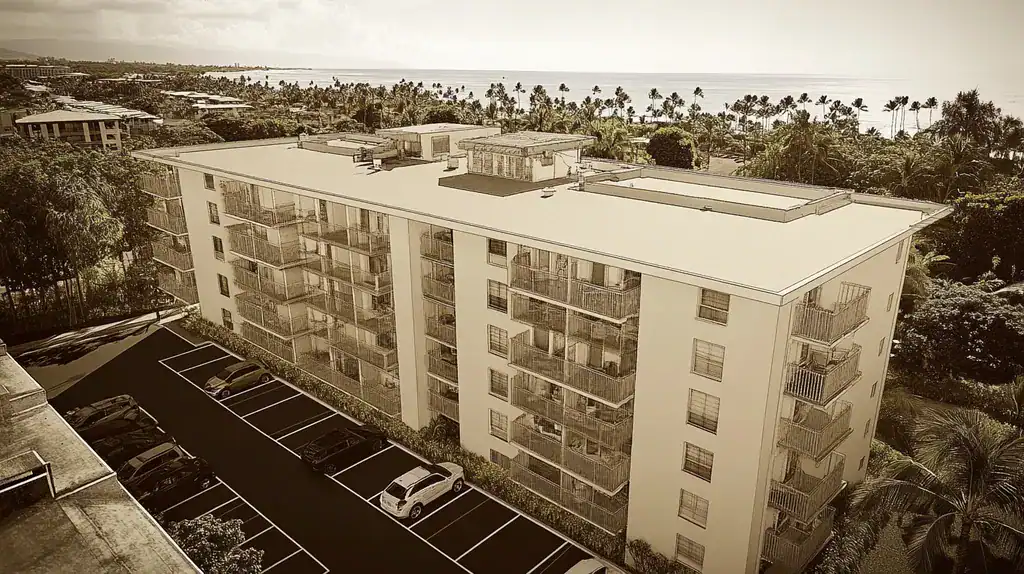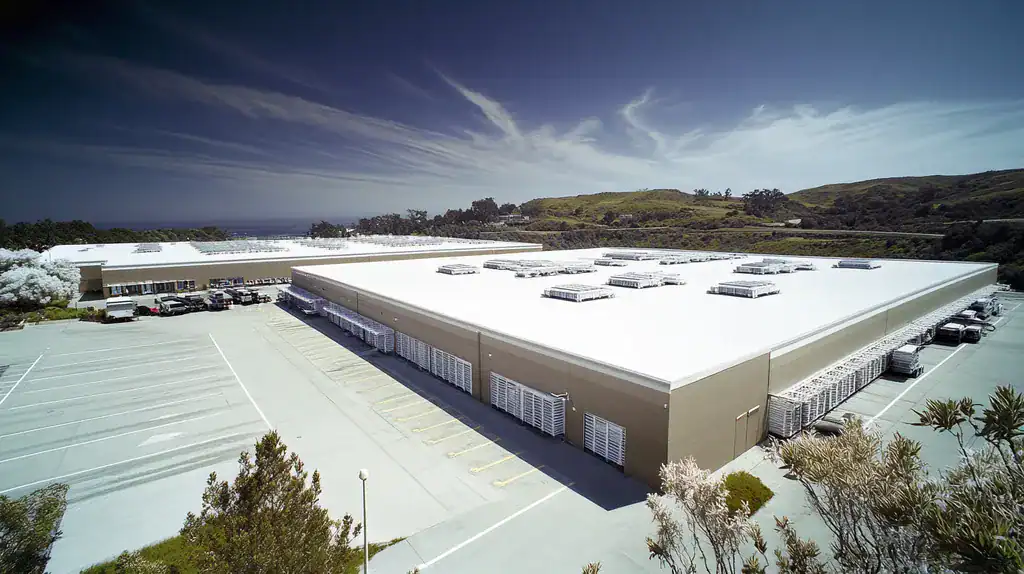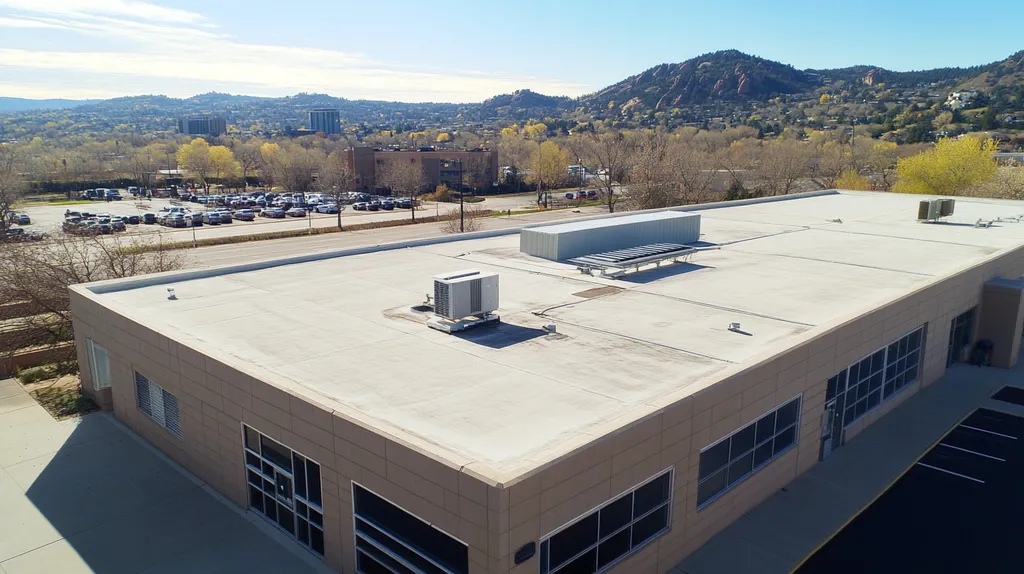As extreme weather events intensify across North America, commercial roofs face unprecedented challenges, with annual storm damage now exceeding $2.8 billion annually. Traditional roofing approaches increasingly fail against these mounting pressures, leaving businesses vulnerable to catastrophic damage and costly downtime.
Understanding how commercial roofs handle extreme conditions has become essential for protecting valuable assets and maintaining business continuity. Modern roofing systems must integrate multiple defensive strategies while balancing cost-effectiveness and operational efficiency.
This comprehensive guide examines critical factors in roofing resilience, from material selection to installation methods, helping property owners and facility managers make informed decisions for long-term protection.
SECTION 1: THE BASICS EXPLAINED
Extreme weather poses an unprecedented challenge to commercial roofs, with damage costs reaching record levels each year. Modern roofing systems must withstand increasingly severe storms, temperature swings, and weather events that test their structural integrity. Understanding how commercial roofs handle these conditions is essential for protecting valuable assets and maintaining business continuity.
What It Is (In Plain Language)
Commercial roofing systems are sophisticated structures designed to protect large buildings from environmental threats. Unlike residential roofs, these systems typically cover vast areas and incorporate multiple layers of protection, including waterproof membranes, insulation, and specialized coating materials.
Most commercial roofs are either flat or low-slope, requiring careful engineering to prevent water accumulation. These designs must balance proper drainage with structural support, often incorporating internal gutters and emergency overflow systems.
The outer layer uses materials specifically chosen for local weather conditions, from heat-reflecting TPO membranes to impact-resistant metal panels. Heavy-duty impact-resistant materials are engineered to withstand strong winds and flying debris, with some insurance companies offering premium discounts for their use. (source: Roofsnap Blog)
Why It Matters (To Your Building)
A robust commercial roof serves as the primary defense against severe weather, protecting everything beneath it. When this barrier fails, the consequences cascade throughout the building, affecting structural integrity, interior systems, and business operations.
Weather-related roof damage often leads to extensive secondary problems, including mold growth, compromised insulation, and weakened structural components. These issues compound over time, potentially resulting in complete system failure if left unaddressed.
The financial impact extends beyond immediate repair costs. Business interruption, damaged inventory, and increased energy costs from compromised insulation can significantly affect an organization’s bottom line.
How It Works
Modern commercial roofing systems employ multiple defense mechanisms against extreme weather. The primary membrane creates a waterproof barrier, while underlying layers provide insulation and structural support.
Strategic drainage design prevents water accumulation through a network of slopes, drains, and scuppers. This system must handle both typical rainfall and extreme precipitation events without allowing standing water.
Attachment methods play a crucial role in wind resistance. Mechanical fasteners, adhesives, and ballast systems secure roofing components to the structure, each chosen based on local wind zone requirements and building height.
The entire system works together to manage thermal stress, water infiltration, and wind uplift forces. Regular inspections ensure all components continue functioning as designed, maintaining the roof’s protective capabilities.
SECTION 2: PRACTICAL APPLICATIONS
Weather-related roof damage costs commercial property owners billions annually, with increasingly severe storms testing even the most robust systems. Understanding practical applications of weather-resistant roofing is no longer optional – it’s essential for business continuity and asset protection. Modern commercial roofing must integrate multiple defensive strategies while maintaining cost-effectiveness and operational efficiency.
Common Uses & Examples
Roof construction must adapt to specific regional challenges, from hurricane zones to areas with heavy snowfall. Material selection and structural systems directly impact a building’s resilience against local weather patterns.
Impact-resistant membranes and reinforced flashings provide critical protection in hail-prone regions. These systems often incorporate multiple layers of protection, including specialized impact-absorbing underlayments.
Cool roofing solutions dominate in high-temperature zones, reflecting solar radiation and reducing thermal stress. These systems typically combine reflective coatings with proper ventilation to maximize performance.
Roof construction must consider climate and energy design considerations, including selection of materials and structural systems that meet regional weather challenges. (source: Architectural Graphic Standards)
When You Need It Most
Severe weather events demand peak performance from commercial roofing systems. During intense storms, properly designed drainage systems prevent water accumulation and potential collapse.
Winter conditions test a roof’s ability to handle freeze-thaw cycles and snow loads. Strategic insulation placement and heated drainage systems help prevent ice dam formation.
Hurricane season requires roofs to resist both high winds and wind-driven rain. Enhanced attachment methods and proper edge securement become crucial during these events.
Extreme heat waves stress roofing materials to their limits. Expansion joints and proper ventilation help maintain structural integrity during thermal cycling.
Interactions With Other Systems
Commercial roofs must work in concert with building envelope systems to maintain proper air and moisture control. This integration affects everything from energy efficiency to indoor air quality.
HVAC equipment mounted on roofs requires special attention to prevent mechanical damage and maintain watertight conditions. Proper curb heights and equipment spacing protect both the roof and mechanical systems.
Lightning protection systems demand careful integration to maintain roof warranty compliance. Attachment methods must not compromise the roof’s waterproof integrity.
Structural elements supporting solar installations or green roof components need enhanced load capacity. These additions require careful planning to maintain both functionality and protection.
SECTION 3: KEY TERMINOLOGY DECODED
Commercial roofing terminology can mean the difference between a resilient installation and catastrophic failure during extreme weather events. Property owners and facility managers must navigate complex technical specifications that directly impact their building’s protection. Clear understanding of industry terms, measurements, and standards enables informed decision-making when selecting materials and systems that will face increasingly severe weather challenges.
Essential Terms Explained
Wind uplift resistance represents a critical factor in roof performance during storms. This measurement indicates how well roofing materials resist being lifted and separated from the substrate by strong winds, with higher ratings providing better protection.
Thermal movement describes how roofing materials expand and contract with temperature changes. Understanding this concept helps predict stress points and potential failure areas during extreme temperature swings.
Load capacity defines how much weight a roof can safely support, particularly important during heavy snow or rain events. This specification must account for both dead loads (permanent equipment) and live loads (temporary weight from weather conditions).
The US Army Corps of Engineers emphasizes standardized terminology for proper material handling and risk mitigation in extreme conditions, establishing clear protocols for construction safety and system longevity. (source: US Army Corps of Engineers)
Industry Jargon Translated
Membrane systems refer to continuous waterproof barriers that protect the building interior. These can be single-ply (one layer) or built-up (multiple layers), each offering different levels of weather resistance.
Flashing components direct water away from roof penetrations and transitions. These critical elements prevent water infiltration at the most vulnerable points of the roofing system.
Substrate integrity describes the condition of the base materials supporting the roof. A compromised substrate can lead to system failure even with high-quality surface materials.
Edge securement encompasses the various methods used to anchor roof edges against wind forces. Proper edge detail design prevents membrane peeling and system failure during high winds.
Measurement & Units Simplified
R-value measures thermal resistance, with higher numbers indicating better insulation properties. This rating helps predict energy efficiency and temperature control capabilities.
Wind uplift ratings use pounds per square foot (psf) to indicate resistance to wind forces. These measurements determine whether a system meets local building code requirements for severe weather conditions.
Impact resistance classifications range from Class 1 to Class 4, with Class 4 offering the highest protection. These ratings help property owners select appropriate materials for hail-prone regions.
Fire resistance ratings use Class A, B, or C designations, with Class A providing the highest level of protection. Understanding these classifications ensures compliance with safety regulations and insurance requirements.
SECTION 4: DECISION FACTORS
Commercial property owners face increasingly complex decisions when selecting roofing systems capable of withstanding extreme weather. With weather-related damages reaching record levels, choosing the wrong system can result in catastrophic failures and business interruptions costing hundreds of thousands of dollars. Understanding the interplay between cost, performance, and longevity has become essential for protecting valuable assets and maintaining operational continuity.
Cost Considerations
Initial roofing costs represent only a fraction of the total investment over a system’s lifetime. Premium materials and expert installation may increase upfront expenses by 20-30%, but often reduce long-term maintenance costs and extend service life significantly.
Insurance considerations play a crucial role in cost calculations. Many carriers offer substantial premium reductions for installing weather-resistant systems that exceed minimum code requirements.
Energy efficiency impacts operational costs throughout the roof’s lifespan. High-performance systems can reduce cooling expenses by 15-25% in hot climates through enhanced reflection and insulation properties.
Emergency repairs during extreme weather events often cost 3-4 times more than scheduled maintenance. Investing in quality materials and proper installation helps avoid these unexpected expenses.
Performance Trade-offs
Metal roofing systems offer superior durability and wind resistance up to 140 mph, while providing excellent fire protection and heat reflection capabilities. These systems excel in areas prone to hurricanes, wildfires, and extreme heat conditions. (source: Quick Roofing)
Single-ply membranes provide excellent waterproofing and flexibility but may require additional reinforcement against impact damage. Their performance depends heavily on proper installation and seam quality.
Built-up roofing systems offer superior protection against water infiltration and mechanical damage. However, they add significant weight to the structure and take longer to install.
Modified bitumen systems balance durability with ease of maintenance. Their multi-layer construction provides redundant protection but may require more frequent inspections of surface coatings.
Lifespan & Durability Factors
Weather exposure significantly impacts roofing system longevity. UV radiation, temperature cycling, and moisture can reduce expected lifespans by 25-40% without proper material selection and maintenance.
Regional climate patterns dictate optimal material choices. Coastal areas require enhanced corrosion resistance, while regions with extreme temperature swings need materials with superior thermal stability.
Installation quality directly affects system durability. Proper attachment methods, flashing details, and drainage design can double the effective lifespan of roofing materials.
Regular maintenance programs extend system longevity by identifying and addressing potential failure points before they develop into major issues. Scheduled inspections and repairs typically cost 75% less than reactive maintenance.
SECTION 5: COMMON CHALLENGES
Commercial roofing systems face unprecedented threats from extreme weather events, with damage costs reaching record levels annually. Industry data shows that over 40% of roof failures occur during severe weather incidents, often due to pre-existing vulnerabilities that went unaddressed. Understanding and proactively addressing common challenges has become critical for protecting commercial properties and maintaining business continuity in an era of increasingly volatile weather patterns.
Frequent Problems & Solutions
Metal roofs provide superior protection against extreme weather conditions, withstanding wind speeds up to 140 mph while offering Class 4 impact resistance against large hailstones. Their non-combustible nature adds crucial protection against lightning strikes, making them particularly valuable in storm-prone regions. (source: Saint Charles Roofing)
Water infiltration remains a persistent challenge, often occurring at membrane seams and penetration points. Regular inspection and maintenance of these vulnerable areas can prevent costly interior damage and structural deterioration.
Wind uplift forces create significant stress on roofing systems, particularly at corners and edges. Enhanced attachment methods and reinforced perimeter details help maintain system integrity during severe storms.
Thermal cycling causes materials to expand and contract repeatedly, leading to potential separation and failure. Proper expansion joint placement and material selection can minimize these effects.
Warning Signs To Watch For
Surface blistering and membrane ridging indicate trapped moisture or air within the roofing system. These conditions typically worsen over time, requiring prompt investigation and repair.
Deteriorating flashings around roof penetrations often signal impending leaks. Regular inspection of these critical components helps prevent water infiltration at vulnerable points.
Standing water remaining 48 hours after rainfall indicates drainage problems that can lead to premature material failure. Addressing drainage issues promptly prevents accelerated deterioration of roofing materials.
Visible seam separation or membrane shrinkage requires immediate attention to prevent system failure. These conditions often worsen rapidly during extreme weather events.
Preventative Approaches
Implementing a comprehensive maintenance program reduces emergency repair costs by up to 70%. Regular inspections should occur at least bi-annually and after significant weather events.
Drainage system maintenance prevents many common roofing problems. Keeping gutters, drains, and scuppers clear ensures proper water removal during heavy precipitation.
Documentation of all inspections and repairs creates a valuable history for tracking system performance. This information helps identify recurring issues and plan for future improvements.
Professional assessment of aging systems helps anticipate potential failures before they occur. Early intervention typically costs significantly less than emergency repairs during extreme weather events.
SECTION 6: NEXT STEPS & RESOURCES
As extreme weather events intensify, commercial property owners must take decisive action to protect their roofing investments. Recent industry data shows that buildings with properly specified and maintained roofing systems experience 70% fewer weather-related failures. Taking the right steps now – from selecting qualified providers to understanding current standards – can mean the difference between resilience and catastrophic failure during severe weather events.
Questions To Ask Providers
Commercial roofs face unique regional challenges that demand specialized expertise from roofing contractors. Property owners should request detailed documentation of a provider’s experience with similar buildings and weather conditions in their specific area.
Demand clear explanations of proposed materials and installation methods, including wind ratings, impact resistance, and thermal performance. Quality providers will readily share testing data and certification details that validate their recommendations.
Request multiple references from projects completed within the last three years that have faced similar weather conditions. Contact these references specifically about system performance during extreme events.
From wind-resistant measures to impact-resistant materials, each region faces unique challenges that can compromise building structures. Aquila Commercial emphasizes implementing a continuous load path from roof to foundation to enhance wind resistance in storm-prone areas. (source: Aquila Commercial)
Industry Standards & Guidelines
Current roofing standards reflect evolving weather patterns and improved understanding of system performance. Property owners should familiarize themselves with ASTM testing protocols for wind resistance, impact rating, and material durability.
Factory Mutual (FM) and Underwriters Laboratories (UL) testing requirements provide crucial benchmarks for system performance. These standards help ensure selected materials will perform as needed during severe weather events.
Building codes establish minimum requirements, but rarely reflect optimal protection levels. Consider exceeding code requirements in critical areas like attachment methods, drainage capacity, and edge metal specifications.
Review insurance carrier guidelines and requirements carefully. Many providers offer significant premium reductions for systems that exceed minimum standards and incorporate enhanced weather protection features.
Further Learning Simplified
Professional organizations like NRCA and IIBEC offer targeted education programs for property owners and facility managers. These resources provide practical guidance for making informed roofing decisions.
Industry publications and technical bulletins deliver regular updates on emerging materials and installation techniques. Subscribe to reputable sources that focus specifically on commercial roofing applications.
Manufacturer training programs offer valuable insights into proper material selection and application methods. Many providers now offer virtual learning options that make education more accessible.
Local roofing associations frequently host seminars and workshops addressing regional weather challenges. These events provide opportunities to network with experienced professionals and learn from real-world examples.
Looking Ahead
With annual storm damage now exceeding $2.8 billion and rising yearly, commercial property owners can no longer afford to take a reactive approach to extreme weather protection.
The increasing frequency and intensity of severe storms, temperature swings, and precipitation events demand comprehensive roofing strategies that integrate multiple defensive measures.
Success requires careful material selection, proper installation methods, and regular maintenance programs that address vulnerabilities before they lead to catastrophic failures.
By understanding critical factors in commercial roof performance and working with qualified providers, property owners can develop resilient systems that protect their assets even as weather patterns become more challenging.
The time to act is now – tomorrow’s extreme weather events will test every weakness in today’s roofing decisions.
FREQUENTLY ASKED QUESTIONS
Q. What are the basics of a commercial roof in extreme weather?
A. Commercial roofs are designed to protect large buildings from severe weather challenges. They consist of multiple layers that ensure waterproofing and insulation while preventing water accumulation. This structure is crucial for maintaining the integrity of the building during extreme weather events.
Q. What practical applications exist for weather-resistant commercial roofs?
A. Weather-resistant roofing must adapt to local conditions, ensuring protection against specific weather events. Material choices play a vital role; for instance, impact-resistant membranes in hail zones and cool roofing solutions in hot climates help maintain building safety and efficiency.
Q. What key terminology should I know about my commercial roof?
A. Understanding roofing terms is essential for effective management of commercial roofs. Key concepts like wind uplift resistance, thermal movement, and load capacity help evaluate the roofing system’s ability to withstand extreme weather and ensure long-term durability.
Q. What decision factors are critical for choosing a commercial roof?
A. When selecting a commercial roof, consider initial costs, performance capabilities, and long-term durability. It’s crucial to understand the balance between cost-effective materials and those that offer superior protection against extreme weather patterns, which can save money in the long run.
Q. What common challenges do commercial roofs face during extreme weather?
A. Commercial roofs often contend with issues like water infiltration, wind uplift, and thermal cycling. Regular inspections can prevent these common challenges from escalating into severe problems, safeguarding the building and minimizing repair costs.
Q. What next steps should I take for my commercial roof?
A. To enhance your commercial roof’s resilience, thoroughly vet roofing providers and understand current standards. Familiarize yourself with industry testing protocols and maintain a proactive maintenance schedule, ensuring your roof remains in optimal condition to withstand extreme weather.
Q. How can regular maintenance benefit my industrial roof?
A. Regular maintenance significantly extends the lifespan of industrial roofs. It allows for early detection of vulnerabilities like leaks or material degradation, ensuring timely repairs. This proactive approach minimizes costly emergency interventions and helps maintain business continuity during extreme weather.










